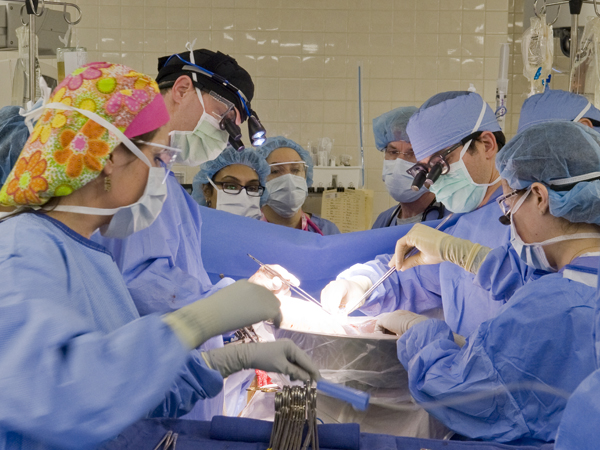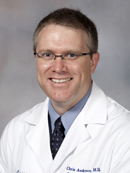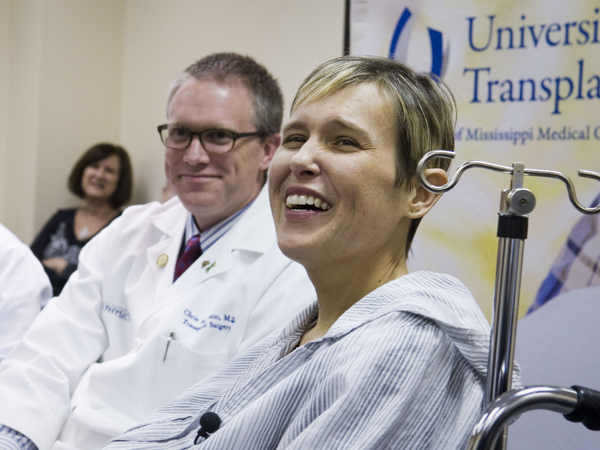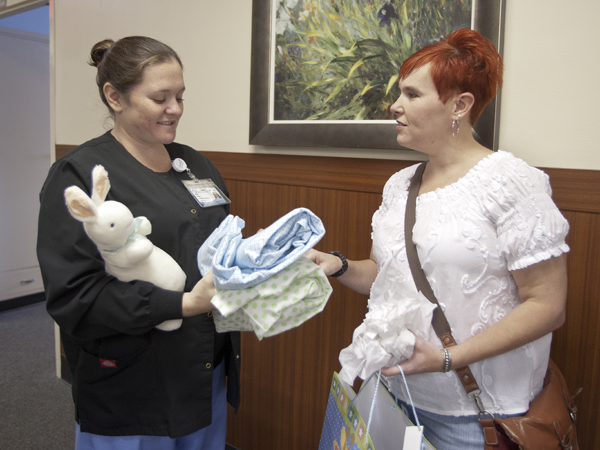Liver allocation proposal could weaken UMMC transplant program

A potential proposal to change the way donated livers are distributed for transplant nationwide could potentially significantly decrease the number of people receiving a new liver at the University of Mississippi Medical Center – and could cause Mississippians with end-stage liver disease to wait longer for a life-saving organ, and possibly die waiting.
It could mean livers donated by Mississippians that are matches for patients waiting for a transplant at UMMC instead might go to a patient in a different region of the country whose residents don’t donate organs at the rate Mississippians do.

"My concern is that could disparage our patients here," said Dr. Christopher Anderson, chairman of the Department of Surgery and leader of UMMC's transplant program. "The (proposed) new model would dramatically change the liver allocation algorithm. Some estimates have suggested that there could be great shifts in volumes of livers transplanted at existing programs.
"Some would increase while others decreased," Anderson said. "Some estimates are that the volume shifts could be as high as 50 percent."
The idea behind the change comes from the fact that in certain areas of the country, such as the East and West coasts, patients can wait longer for a liver transplant because donation rates are lower. Anderson said that one of the driving forces of the proposed change stems from one of many governing principles for organ transplantation in this country that stipulate a patient's place of residence shouldn't affect allocation of organs.
But because of significant differences in the number of donated organs per capita throughout the country, Anderson said, those pushing the change want to redirect donor livers away from areas with high donation rates to areas where donated livers are fewer. He said the debate is "confounded by other governing principles of organ donation that mandate the avoidance of wasting organs, avoiding futile transplants, and increasing the utility of the available donated organs.
In addition to conflicting principles, "the reality of the cost of transplantation is playing a large role in this debate as well," Anderson said.
Anderson, a member of the federally contracted United Network for Organ Sharing's (UNOS) liver and intestines transplantation committee, is helping to guide members of the transplant community in finding a balance that would help meet the needs of the greater transplant community, but preserve local access to livers. During a September meeting of that committee, Anderson was also appointed to a new logistics and transportation subcommittee that will study logistics of a change in the current system, such as having to fly livers much longer distances for transplant.
Newly formed UNOS subcommittees will report back in May. "We will decide where to go from there," Anderson said.
UNOS decides which states are in which of the nation's 11 organ transplant regions, with Mississippi being in Region 3. The current liver transplant allocation system is based in general on severity of a person's disease. Because the number waiting for a liver is far more than available organs, usually only the most critically ill get a transplant. There's a regional sharing policy dating from 2013 which directs livers to patients throughout the region should they be sicker than patients at a local transplant center, Anderson said.
The Mississippi Organ Recovery Agency is the organ procurement organization, or OPO, that takes in almost all of Mississippi. "If a Mississippi patient is listed to receive a liver at our center, and there is a donor available via MORA, the liver would allocate first to patients here," Anderson said. "If we didn't have a suitable candidate, then it would be allocated to another patient in our region.
"It's a fair system designed to get the sickest people a transplant faster," Anderson said. UMMC teams transplanted 21 livers through Oct. 15 of this year, in addition to 82 kidneys, eight hearts, 10 kidney-pancreases combinations, and one isolated pancreas.

The proposal hits home for south Jackson mom Karen Battle. The UMMC team transplanted her new liver on March 4, 2013. Battle was so gravely ill that only a transplant could have saved her life. It was the first liver transplant at UMMC in 22 years and, thanks to Anderson’s recruitment of a top-flight team of specialists, marked the return of the Medical Center’s liver transplant program.
“I got listed on a Friday, and that following Monday, I was in surgery,” said Battle, 38. She matched with an organ donated in Florida, a state in Mississippi’s transplant region.
UNOS measures severity of liver disease based on what’s called MELD (Model for End-Stage Liver Disease) scores ranging from 6, the least ill, to 40, considered gravely ill. In some areas of the country, such as California, the average MELD at transplant is over 30, Anderson said. But in Region 3, the median MELD score is closer to 25, he said.
Region 3 also includes Arkansas, Louisiana, Alabama, Georgia and Puerto Rico, where many residents cope with diabetes, obesity, heart disease and stroke. “We’re a lot alike and have many of the same challenges. It makes sense that we are grouped together,” Anderson said.
Proponents of the change, however, want “the median score to be the same everywhere,” Anderson said. They advocate dividing the nation into fewer, bigger districts – perhaps eight, or as few as four - and say that re-juggling will even out differences in the MELD system.
“What’s being talked about is a radical change from the past,” Anderson said. “The first concept is based on research modeling projections that group areas of the country together to achieve a similar MELD score at transplant.”
But, he said, “in order to achieve this, there would be no local OPO or state boundaries. It would all be treated as one big list.”
For example, he said, Mississippi would be grouped with states not currently part of Region 3. All patients listed in that group would compete for the same donor pool. There would be no preference given to organs donated in Mississippi staying in Mississippi, Anderson said.
“They could instead travel a long distance to be transplanted elsewhere,” Anderson said. “The end result is that the larger states and larger programs could be allocated livers that today would preferentially go to local patients.”
It’s a similar situation in Georgia, which could be remapped into a region of northeastern states. Lawmakers there say the changes could mean 25 percent fewer liver transplants in the state, and – like in Mississippi - disproportionately impact minorities and poorer patients.
Data compiled to support the current concepts don’t consider that UMMC’s program “didn’t exist when they ran this data,” Anderson said.
During the years 2009-11, an average 44 Mississippians waited for a liver transplant, said Kevin Stump, MORA’s chief executive officer. About a third of them died while waiting, he said.
“Over the last four years, MORA has had one of the highest consent rates in the country for donation,” Stump said. Between 2010 and 2013, the number of livers recovered in Mississippi for transplant ranged from 54 to 68 annually, MORA statistics show.
Eighteen livers - 13 from in-state donors and five from out of state - were transplanted at UMMC in 2013, when the Medical Center’s program resumed.
Battle sympathizes with patients in donor-poor regions. “Everybody should have a second chance at life.
“But, if it’s donated here, it needs to stay here,” she said. “Those other states need to fight just as hard to get people to donate as the states with high donation rates.”
“There’s data that say livers are being shared a lot more within regions, and in our short history here, we have benefited from the current policy,” Anderson said. Based on current experience with broader sharing, the discussed concept would mean higher costs for flying organs, longer distances, longer travel time for surgeons to reach a donor to remove his organs, and more time that a liver is iced down during travel.
A potential consequence of such a policy change, Anderson said, could be that “smaller (transplant) centers which often serve economically and racially disparaged populations might have to close because they can no longer compete with larger centers that would be getting more of the organs,” Anderson said. “This would largely be due to the unintended increase in costs associated with the transplant procedure.
“If we change the system, we need to have as few unintended consequences as possible.”

A comprehensive study of the nation’s organ donation system by the University of Wisconsin, posted on its website, shows that if each of the nation’s organ procurement organizations had two more donors annually, “it would improve the situation more than a new policy would,” Anderson said. “Do we really need a radical change in policy if we don’t know if other less costly initiatives can achieve the same goal?
“These are some of the questions that the transplant community must work together to answer before we consider changes.”
“Every time there’s a discussion about possible changes in organ allocation, our first concern is: What would be the impact for Mississippians? Will there be a greater good from this?” Stump said.
“As we discuss the proposed changes, we don’t really see the greater good for anyone,” said Stump, appointed to UNOS’ subcommittee on liver donation and utilization to study how best to make sure livers get transplanted, and possible obstacles. So far in 2014, MORA has recovered 38 livers, with 36 being transplanted, 15 of which were at UMMC, Stump said. Another six livers were “imported” to UMMC from other OPOs based on the current sharing policy.
“At the end of the day, we all want to decrease the number of patients dying on a waiting list. We’ve had many really ill patients here who died (since 2013) before they could get an organ,” Anderson said. “We do have wait list mortality here, and in theory, this could increase with a change in policy. Ours could increase so that someone else’s could decrease.”


